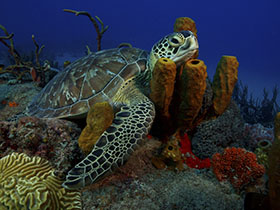Deakin scientists watch tagged turtles from space
Media releaseMillions of kilometres of protected marine parks covering vast tracts of ocean may not be enough to save some of the world's migrating sea life.
Unique research by Deakin University scientists using satellite tracking to monitor tagged green turtles has found the turtles move in and out of enormous protected marine conservation zones, exposing them to danger as they migrate from their breeding grounds to forage for food.
The findings indicate that even the largest Marine Protection Areas (MPAs) – some covering hundreds of thousands of square kilometres of sea – may need to be buttressed with smaller networks of protected areas, according to Deakin University Chair of Marine Science Professor Graeme Hays.
An international team from Deakin University's Centre for Integrative Ecology (CIE), Swansea University (UK) and the Seychelles located green turtles nesting ashore at night and fitted them with satellite tags.
They then used satellites to monitor the turtles moving from their breeding grounds in the Chagos Archipelago in the Indian Ocean, one of the largest protected marine parks in the world covering 640,000 km2 and renowned for its pristine coral reefs and schools of endangered species.
"Over the last few years, governments around the world have declared some massive marine parks, typically around ocean islands,'' Professor Hays said. "How well these protect marine life has been heavily debated."
The research results revealed some extraordinary data, including an epic voyage of 3979km by one turtle, the longest published migration of an adult ever recorded. Tracking also recorded two swimming more than 3800km westwards to the coast of Somalia on mainland Africa while another headed 1000km north to the Maldives.
The data also revealed that seven out of eight of the tracked turtles swam more than 1000km outside the protected zones.
"The Chagos Archipelago protected area certainly has huge conservation benefit," Professor Hays said.
"In addition to protecting coral reefs and other important habitats and species, it will also protect turtles during key periods of their lives such as when they are nesting and when the eggs are incubating."
But Professor Hays said international cooperation is needed to develop an additional network of smaller, preserved areas across the Indian Ocean to protect the turtles at other times in their lives.
The report findings, titled "Use of long-distance migration patterns of an endangered species to inform conservation planning for the world's largest marine protection area", is published in Conservation Biology this week.
Green sea turtles are vegetarian, feeding on algae and kelp. They can grow 1.5m in length, weigh around 300kg and live for up to 80 years. They are found in tropical and subtropical waters, predominately in the Atlantic and Pacific oceans.
Endangered, the turtles are hunted legally and illegally for human consumption or fall victim to fishery bycatch or boat collision as they move through the seas.
Professor Hays said the joint, international research revealed migrating marine life demonstrated different types of long distance movement, with turtles often shuttling between small breeding grounds and foraging areas compared with fish that range more broadly.
He believes the results of the study could also apply to endangered and commercially exploited fish, such as sharks and tuna.
Marine Protection Areas (MPAs) cover vast tracts of ocean, spreading from small plots of a few hundred kilometres to vast areas canvassing more than 100,000 square kilometres. The Chagos Archipelago is among one of the world's largest MPAs. Another 360,000 square kilometres around the Hawaiian Islands is also protected.
"This massive MPA is of value for green turtles, particularly as it protects them throughout the breeding season. But our work shows that even massive MPAs need to be supplemented with networks of smaller protected areas."
Covered with an anti-fouling paint used on boats, some of the tags survived for more than a year, with one still active 15 months later.
Professor Hays said MPAs were large areas, hundreds of thousands of square kilometres, set up by governments around the world over the last decade as part of a global effort to reduce ocean biodiversity declines.
"Yet the effectiveness of these protected areas is often not known particularly for migratory species.
"We hope that these results will now feed in to international conservation planning that is underway in the Indian Ocean and other ocean basins."
Share this story
 Photograph courtesy of R.D Kirkby and B.S Kirkby
Photograph courtesy of R.D Kirkby and B.S Kirkby
